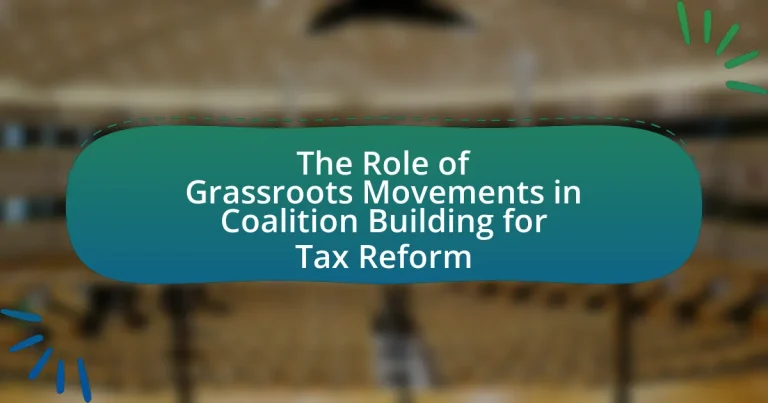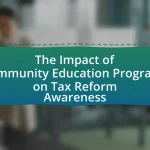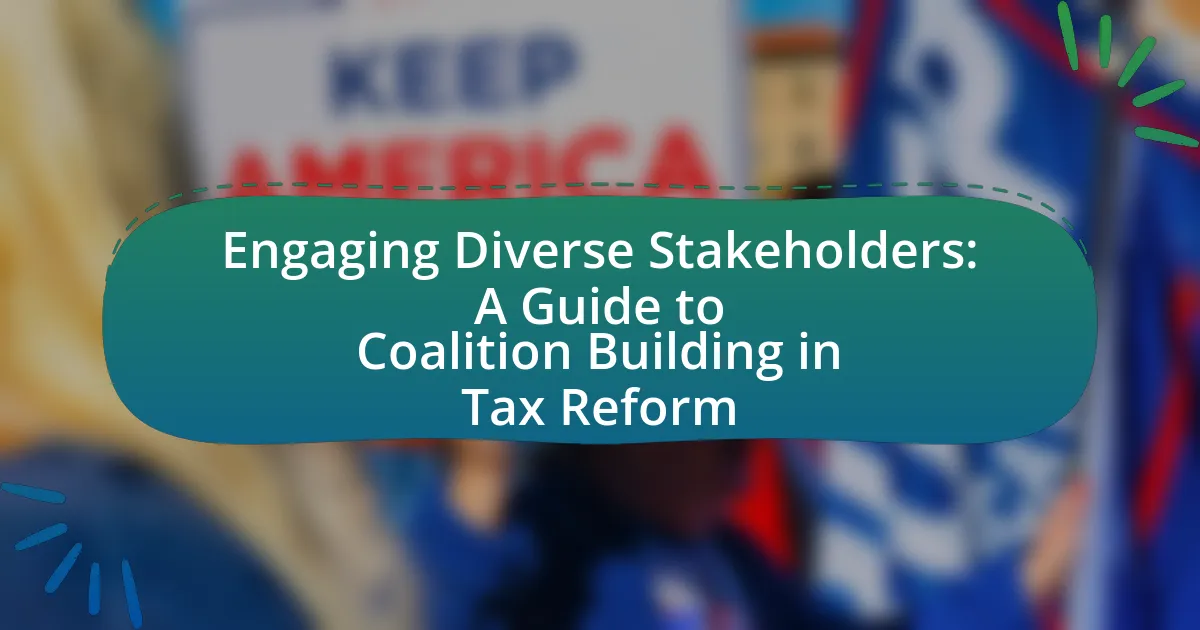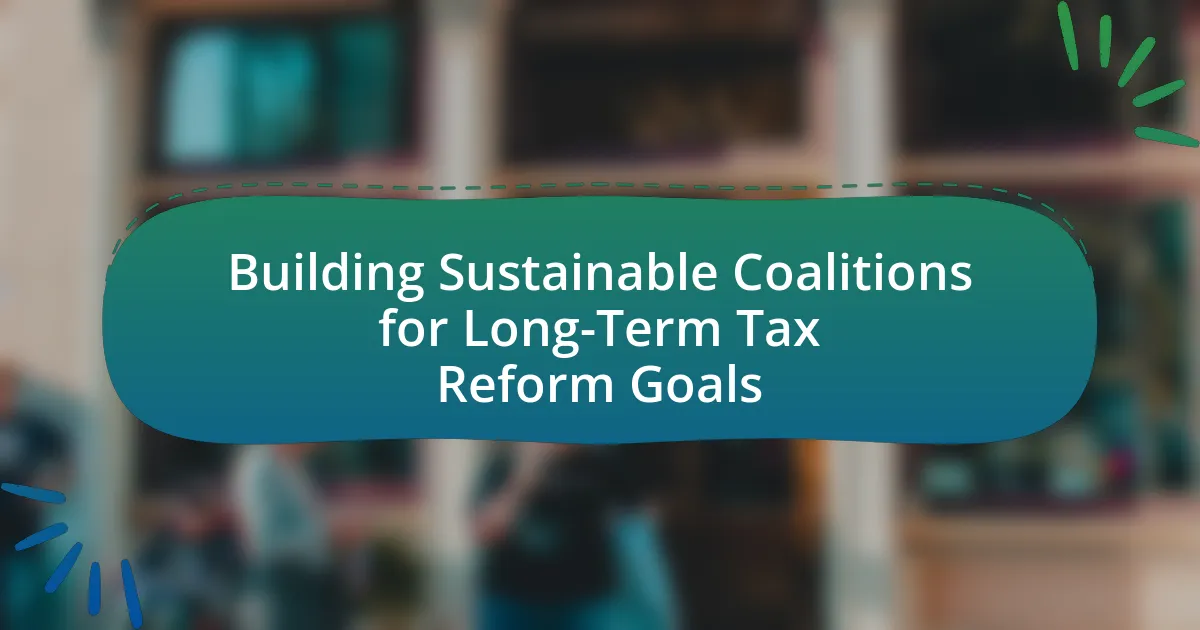Grassroots movements are organized efforts by ordinary citizens aimed at influencing political decisions, particularly in the realm of tax reform. This article explores the significance of grassroots movements in mobilizing community support, advocating for policy changes, and building coalitions that enhance the legitimacy of tax reform initiatives. It outlines the strategies employed by these movements, such as community organizing and coalition building, while also addressing the challenges they face, including resource limitations and differing stakeholder priorities. Additionally, the article highlights the importance of leadership, storytelling, and social media in sustaining momentum and engagement within these movements, ultimately emphasizing their critical role in shaping tax policy discussions.
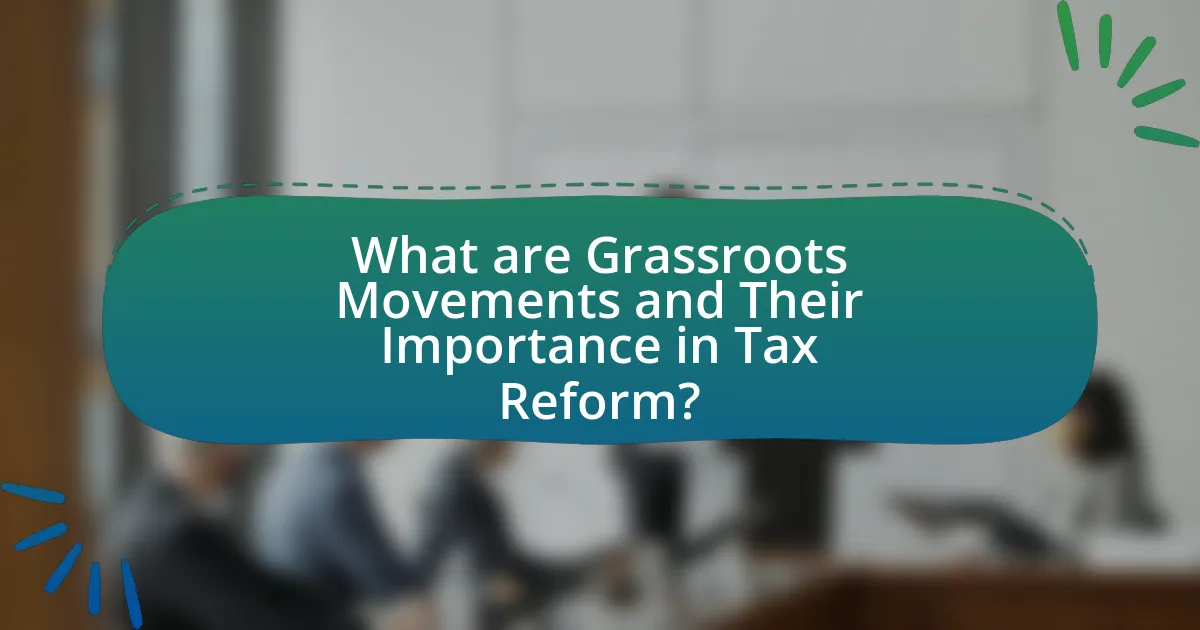
What are Grassroots Movements and Their Importance in Tax Reform?
Grassroots movements are organized efforts by ordinary people to influence political decisions and policies, particularly in tax reform. These movements are crucial because they mobilize community members to advocate for changes that reflect their needs and priorities, often leading to significant policy shifts. For example, the Tea Party movement in the United States successfully influenced tax policy debates in the late 2000s by rallying public support against perceived excessive taxation. Such movements can amplify voices that are often overlooked in traditional political processes, thereby fostering a more inclusive dialogue around tax reform.
How do Grassroots Movements influence Tax Reform initiatives?
Grassroots movements significantly influence tax reform initiatives by mobilizing public support and advocating for policy changes. These movements often raise awareness about tax issues, such as inequality or corporate tax loopholes, which can lead to increased public pressure on lawmakers. For instance, the Tea Party movement in the United States successfully influenced tax policy debates by organizing rallies and leveraging social media to amplify their message, resulting in significant political shifts and legislative outcomes. Additionally, grassroots organizations often collaborate with other stakeholders, creating coalitions that enhance their bargaining power and visibility in the political arena, thereby shaping tax reform agendas.
What strategies do Grassroots Movements employ to advocate for Tax Reform?
Grassroots movements employ strategies such as community organizing, coalition building, and public awareness campaigns to advocate for tax reform. Community organizing involves mobilizing local residents to engage in discussions about tax policies, thereby fostering a sense of collective action. Coalition building allows these movements to unite various stakeholders, including non-profits, labor unions, and advocacy groups, to amplify their voice and influence. Public awareness campaigns utilize social media, town hall meetings, and educational workshops to inform the public about the implications of tax reform, aiming to generate widespread support. These strategies are effective as they leverage local engagement and collective power to challenge existing tax structures and push for equitable reforms.
How do Grassroots Movements mobilize community support for Tax Reform?
Grassroots movements mobilize community support for tax reform by engaging local citizens through education, advocacy, and collective action. These movements often organize town hall meetings, workshops, and social media campaigns to raise awareness about the implications of tax policies and the need for reform. For instance, the “Fair Tax Coalition” successfully mobilized community support by highlighting how tax reforms could alleviate economic disparities, leading to increased participation in advocacy efforts. Additionally, grassroots movements leverage personal stories and testimonials to create emotional connections, thereby fostering a sense of urgency and community solidarity around tax reform initiatives.
Why are Grassroots Movements essential for Coalition Building?
Grassroots movements are essential for coalition building because they mobilize community members, fostering a sense of shared purpose and collective action. These movements engage individuals at the local level, creating a broad base of support that is crucial for influencing policy changes, such as tax reform. For instance, the grassroots efforts behind the 2017 Tax Cuts and Jobs Act demonstrated how local advocacy can unite diverse groups, amplifying their voices in the political arena. By leveraging personal stories and local experiences, grassroots movements effectively highlight the real-world impacts of tax policies, making them vital in forming coalitions that advocate for comprehensive reform.
What role do Grassroots Movements play in uniting diverse stakeholders?
Grassroots movements play a crucial role in uniting diverse stakeholders by fostering collaboration and amplifying collective voices. These movements create a platform where individuals from various backgrounds can come together around shared goals, such as tax reform, thereby bridging gaps between different interests and perspectives. For instance, the grassroots movement for tax reform in the United States has successfully brought together community organizations, advocacy groups, and concerned citizens, demonstrating that collective action can lead to significant policy changes. Research by the National Community Tax Coalition highlights that grassroots efforts have increased participation in tax policy discussions, leading to more inclusive decision-making processes. This evidence underscores the effectiveness of grassroots movements in mobilizing diverse stakeholders towards common objectives.
How do Grassroots Movements enhance the legitimacy of Tax Reform efforts?
Grassroots movements enhance the legitimacy of tax reform efforts by mobilizing community support and fostering public engagement. These movements create a platform for diverse voices, ensuring that the concerns of various stakeholders are represented, which increases the perceived fairness of proposed reforms. For instance, the 2011 Occupy Wall Street movement highlighted income inequality, leading to increased public discourse on tax policies and influencing legislative agendas. By demonstrating widespread public backing, grassroots movements can compel policymakers to consider reforms that align with the interests of the community, thereby legitimizing the reform process.
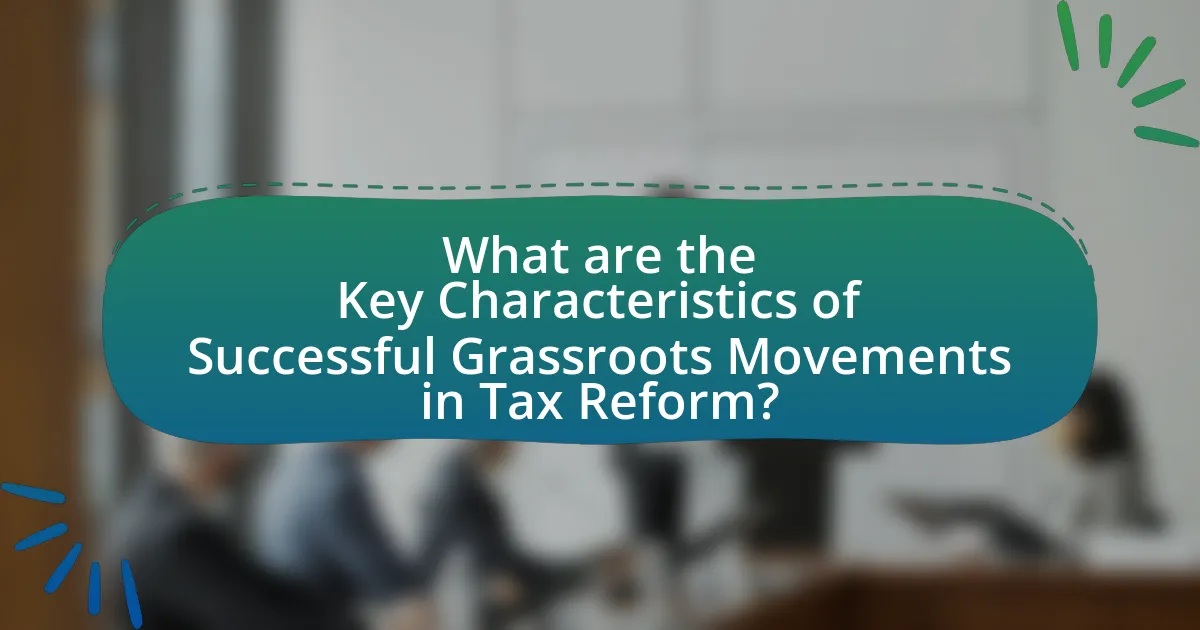
What are the Key Characteristics of Successful Grassroots Movements in Tax Reform?
Successful grassroots movements in tax reform are characterized by strong community engagement, clear messaging, and strategic coalition building. Community engagement fosters a sense of ownership and mobilizes individuals to advocate for change, as seen in movements like the Tea Party, which effectively galvanized local support around specific tax issues. Clear messaging ensures that the goals of the movement resonate with a broad audience, making complex tax reform issues accessible and relatable. Strategic coalition building, exemplified by the collaboration between various stakeholders such as non-profits, local businesses, and advocacy groups, enhances the movement’s influence and reach, as demonstrated in successful campaigns for tax reform in various states. These characteristics collectively empower grassroots movements to effectively challenge existing tax policies and advocate for reform.
What common traits do effective Grassroots Movements share?
Effective grassroots movements share traits such as strong community engagement, clear messaging, and a focus on local issues. Strong community engagement fosters a sense of ownership and participation among members, which is crucial for mobilizing support. Clear messaging ensures that the movement’s goals and objectives are easily understood, allowing for broader outreach and connection with potential allies. A focus on local issues resonates with community members, making the movement more relevant and compelling. These traits have been observed in successful movements like the Fight for $15, which effectively mobilized workers and communities around the issue of minimum wage increases, demonstrating the power of grassroots organization in driving social change.
How does community engagement contribute to the success of Grassroots Movements?
Community engagement is essential for the success of grassroots movements as it fosters collective action and mobilizes local support. When individuals actively participate in their communities, they build trust and solidarity, which are crucial for effective advocacy. For instance, grassroots movements that engage community members in discussions and decision-making processes are more likely to resonate with the public, leading to increased participation and support. Research indicates that movements with strong community ties can achieve greater visibility and influence, as seen in the successful campaigns for tax reform that leveraged local networks to amplify their message and gather resources.
What role does leadership play in the effectiveness of Grassroots Movements?
Leadership is crucial for the effectiveness of grassroots movements as it provides direction, motivation, and organization. Effective leaders in grassroots movements mobilize community members, articulate shared goals, and foster a sense of collective identity, which enhances participation and commitment. For instance, leaders like those in the Civil Rights Movement, such as Martin Luther King Jr., effectively galvanized support and coordinated actions that led to significant legislative changes. Research indicates that strong leadership correlates with increased engagement and successful outcomes in grassroots initiatives, as leaders can navigate challenges and maintain momentum.
How do Grassroots Movements build coalitions for Tax Reform?
Grassroots movements build coalitions for tax reform by mobilizing community members, leveraging shared interests, and fostering collaboration among diverse stakeholders. These movements often initiate campaigns that highlight the need for tax reform, engaging citizens through grassroots organizing, social media outreach, and public demonstrations. For instance, the “Fair Tax Coalition” in the United States successfully united various advocacy groups, labor unions, and community organizations to push for equitable tax policies, demonstrating the effectiveness of collective action. By creating a platform for dialogue and collaboration, grassroots movements can amplify their voices and influence policymakers, ultimately leading to more inclusive tax reform initiatives.
What are the steps involved in coalition building for Tax Reform?
The steps involved in coalition building for tax reform include identifying stakeholders, establishing common goals, building relationships, mobilizing support, and maintaining engagement. First, identifying stakeholders involves recognizing individuals and organizations affected by tax policies, such as taxpayers, businesses, and advocacy groups. Next, establishing common goals requires aligning the interests of diverse stakeholders around specific tax reform objectives, such as equity or efficiency. Building relationships entails fostering trust and collaboration among coalition members through meetings and discussions. Mobilizing support involves organizing campaigns, outreach efforts, and public demonstrations to raise awareness and gather broader community backing. Finally, maintaining engagement ensures ongoing communication and collaboration among coalition members to adapt strategies and sustain momentum throughout the reform process. These steps are essential for creating a unified front that can effectively advocate for meaningful tax reform.
How do Grassroots Movements identify and engage potential coalition partners?
Grassroots movements identify and engage potential coalition partners through strategic outreach, shared values, and collaborative initiatives. They often begin by mapping stakeholders who share similar goals, such as tax reform, and then utilize social media, community events, and networking to connect with these entities. For instance, the “Fight for $15” movement successfully engaged various labor unions and community organizations by emphasizing common objectives related to wage increases and economic justice. This approach not only fosters relationships but also builds a united front, enhancing the overall impact of the coalition.
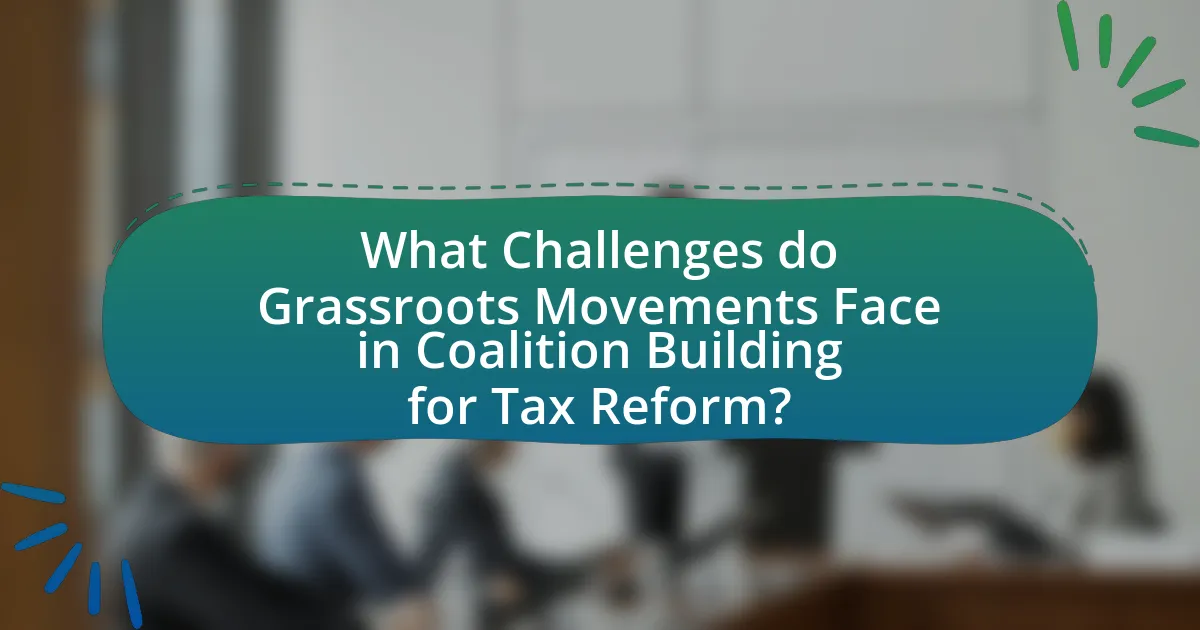
What Challenges do Grassroots Movements Face in Coalition Building for Tax Reform?
Grassroots movements face significant challenges in coalition building for tax reform, primarily due to differing priorities among diverse stakeholders. These movements often struggle to align the interests of various groups, such as labor unions, environmental organizations, and business associations, which may have conflicting views on tax policies. Additionally, limited resources and funding can hinder grassroots efforts to effectively mobilize and sustain coalitions. Research indicates that successful coalitions require clear communication and shared goals, yet grassroots movements frequently encounter barriers in establishing these common objectives, leading to fragmentation and reduced effectiveness in advocating for tax reform.
What obstacles hinder the effectiveness of Grassroots Movements?
Grassroots movements face several obstacles that hinder their effectiveness, including limited resources, lack of media coverage, and internal divisions. Limited resources restrict the ability to mobilize supporters and sustain campaigns, as many grassroots organizations operate on tight budgets and rely on volunteer efforts. Lack of media coverage diminishes visibility and public awareness, making it challenging to gain traction and support for their causes. Internal divisions can lead to conflicts over goals and strategies, weakening the overall impact and coherence of the movement. These factors collectively impede the ability of grassroots movements to effectively influence policy and build coalitions for tax reform.
How do funding and resource limitations impact Grassroots Movements?
Funding and resource limitations significantly hinder grassroots movements by restricting their ability to mobilize, organize, and sustain campaigns. Without adequate financial support, these movements struggle to cover essential costs such as outreach, materials, and event logistics, which are crucial for building community engagement and awareness. For instance, a study by the National Committee for Responsive Philanthropy found that grassroots organizations with limited funding often face challenges in reaching broader audiences, resulting in decreased visibility and impact. Additionally, resource constraints can lead to reliance on a smaller base of volunteers, which may limit the diversity and effectiveness of the movement. Consequently, these limitations can stifle the potential for coalition building necessary for comprehensive tax reform initiatives, as seen in various case studies where well-funded movements achieved greater legislative success compared to their under-resourced counterparts.
What strategies can Grassroots Movements use to overcome these challenges?
Grassroots movements can overcome challenges by employing strategies such as building strong coalitions, leveraging social media for outreach, and engaging in community education. Strong coalitions enhance collective power and resource sharing, which is essential for effective advocacy. For instance, the coalition-building efforts seen in the Fight for $15 movement demonstrate how uniting various stakeholders can amplify demands for wage reform. Leveraging social media allows grassroots movements to reach wider audiences quickly, mobilizing support and raising awareness about tax reform issues. Additionally, community education initiatives empower individuals with knowledge about tax policies, fostering informed advocacy. Research indicates that informed communities are more likely to engage in activism, as seen in studies by the Center for American Progress, which highlight the correlation between education and civic participation.
How can Grassroots Movements sustain momentum for Tax Reform coalitions?
Grassroots movements can sustain momentum for tax reform coalitions by fostering community engagement and leveraging social media for outreach. Engaging local communities through town hall meetings and workshops creates a sense of ownership and urgency around tax reform issues. For instance, the 2017 Tax Cuts and Jobs Act saw grassroots organizations mobilizing constituents to voice their concerns, resulting in increased public discourse and pressure on lawmakers. Additionally, utilizing social media platforms allows these movements to disseminate information rapidly, organize events, and rally support, as evidenced by the success of campaigns like “Tax March,” which effectively galvanized public interest and participation in tax reform discussions.
What methods can be employed to maintain engagement among coalition members?
To maintain engagement among coalition members, regular communication and collaborative decision-making are essential methods. Regular communication ensures that all members are informed about coalition activities, goals, and progress, fostering a sense of belonging and accountability. Collaborative decision-making involves members in the planning and execution of initiatives, which enhances their investment in the coalition’s success. Research indicates that coalitions with high levels of member involvement in decision-making processes report greater satisfaction and commitment, as seen in studies on community organizations and advocacy groups.
How can Grassroots Movements adapt to changing political landscapes?
Grassroots movements can adapt to changing political landscapes by employing flexible strategies that respond to shifts in public sentiment and policy priorities. For instance, they can utilize social media platforms to quickly mobilize supporters and disseminate information, allowing them to pivot their messaging in real-time based on emerging political trends. Historical examples, such as the rapid adaptation of the Tea Party movement in the United States, demonstrate how grassroots organizations can effectively align their goals with the prevailing political climate to influence tax reform discussions. Additionally, grassroots movements can build coalitions with other organizations to amplify their voice and increase their impact, as seen in the collaboration between various advocacy groups during the Fight for $15 campaign, which successfully influenced minimum wage legislation across multiple states.
What Best Practices can Grassroots Movements adopt for Effective Coalition Building?
Grassroots movements can adopt several best practices for effective coalition building, including establishing clear goals, fostering inclusive participation, and maintaining open communication. Clear goals provide a unified direction, which is essential for aligning diverse stakeholders; for instance, the Fight for $15 movement effectively united various labor groups around the common objective of raising the minimum wage. Inclusive participation ensures that all voices are heard, which strengthens the coalition; research shows that diverse coalitions are more effective in advocacy efforts. Open communication facilitates trust and collaboration among coalition members, as demonstrated by the success of the Sunrise Movement in mobilizing youth for climate action through transparent dialogue and shared resources.
How can Grassroots Movements leverage social media for advocacy?
Grassroots movements can leverage social media for advocacy by utilizing platforms to mobilize supporters, disseminate information, and create a sense of community. Social media enables these movements to reach a wider audience quickly; for instance, the #MeToo movement effectively used Twitter to raise awareness about sexual harassment, leading to significant societal discussions and policy changes. Additionally, social media allows for real-time engagement, enabling grassroots organizations to respond to current events and rally support efficiently. According to a study by the Pew Research Center, 69% of adults in the U.S. use social media, highlighting its potential as a tool for advocacy and outreach.
What role does storytelling play in mobilizing support for Tax Reform?
Storytelling plays a crucial role in mobilizing support for tax reform by humanizing complex issues and making them relatable to the public. Through narratives that illustrate the real-life impacts of tax policies, grassroots movements can effectively engage individuals and communities, fostering emotional connections that drive action. For instance, personal stories about how tax reform can alleviate financial burdens or improve public services resonate more deeply than abstract statistics, thereby increasing public support. Research indicates that narratives can significantly influence public opinion, as they simplify complex information and create a sense of urgency, motivating individuals to participate in advocacy efforts for tax reform.
